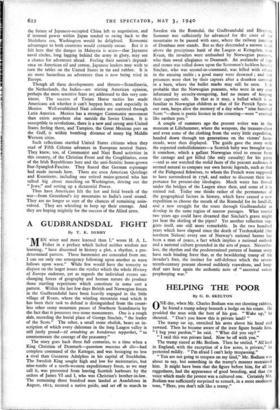A GUDBRANDSDAL FIGHT
By T. K. DERRY
mEN wiser and more learned than I," wrote H. A. L. Fisher in a preface which lacked neither wisdom nor learning, "have discerned in history a plot, a rhythm, a pre- determined pattern. These harmonies are concealed from me. I can see only one emergency following upon another as wave follows upon wave." While few would have the temerity to dispute on the larger issues the verdict which the whole History of Europe endorses, yet as regards the individual events un- changing forces of geography and human nature do produce those startling repetitions which constitute in some sort a pattern. Within the last few days British and Norwegian forces in the Gudbrandsdal have been heavily engaged in the little village of Kvam, where the winding mountain road which it has been their task to defend is distinguished from the count- less other stony mountain passes of Northern Scandinavia by the fact that it possesses two stone monuments. One is a rough slab, recording the burial place of George Sinclair, "the leader of the Scots." The other, a small stone obelisk, bears an in- scription of which every dalesman in the long Laagen valley is still justly proud—ti/ erindring av bondernes tapperhet, "to commemorate the courage of the peasantry."
The story goes back three full centuries, to a time when a King Christian of Denmark—quantum mutatus at, illo—had complete command of the Kattegat, and was besieging no less a rival than Gustavus Adolphus in his capital of Stockholm. The Swedish King sought high and low for mercenaries, but nine-tenths of a north-western expeditionary force, as we may call it, was prevented from leaving Scottish harbours by the orders of James VI and I, who was Christian's brother-in-law. The remaining three hundred men landed at Aandalsnes in August, 1612, secured a native guide, and set off to march to Sweden via the Romsdal, the Gudbrandsdal and Elverum. Summer was sufficiently far advanced for the crest of the mountains to be passed with ease, where the railway junc' of Dombaas now stands. But as they descended a narrow tt .k above the precipitous bank of the Laagen at Kringelen, Iar Kvam, the invaders were ambushed by Norwegian peasants, who then owed allegiance to Denmark. An avalanche of logs and stones was rolled down upon the Scotsmen's luckless heti. , Sinclair, who was second-in-command, was killed with othcrs in the ensuing melee ; a good many were drowned ; and 116 prisoners were shot by their captors after a drunken carousal in a barn, where the bullet marks may still be seen. It is probable that the Norwegian peasants, who were in any case infuriated by atrocity-mongering, had no means of keeping their captives safe. Be that as it may, a ballad which is as familiar to Norwegian children as that of Sir Patrick Spens to our own, keeps alive the memory of a day when "nine hundred Scots "—there is poetic licence in the counting—were "crushed like earthen pots."
A couple of summers ago the present writer was in the museum at Lillehammer, where the weapons, the treasure-chest and even some of the clothing from the sorry little expedition, handed down through ten generations on the victors' farm- steads, were then displayed. The guide gave the story with the expected embellishments—a Scottish baby was brought. into it somehow, which a gallant Norwegian tried to rescue from the carnage and got killed (the only casualty) for his pains —and as one watched the stolid faces of the peasant audience it seemed natural to compare our own heroic legends, such as that of the Fishguard fishwives, to whom the French were supposed to have surrendered in 1798, and rather to discount their im- portance for present-day ideologies. Much water has flowed under the bridges of the Laagen since then, and some of it is stained red. Today one thinks rather of the permanence of the geographical factors in history, which have caused a new expedition to choose the mouth of the Romsdal for its landfall, and a new struggle for the route through Gudbrandsdal m develop in the same region of narrow passages. What tourist two years ago could have dreamed that Sinclair's grave might yet hear the skirling of the pipes? Yet another reflection sug- gests itself, one still more remarkable. In the two hundred years which have elapsed since the death of Tordenskjold (the northern Nelson) every one of Norway's national heroes has been a man of peace, a fact which implies a national outlook and a national culture grounded in the arts of peace. Neverthe- less, the rhythm and the predetermined pattern of human story have such binding force that, at the bewildering tramp of the invader's foot, the instinct for self-defence which the seven- teenth-century peasant showed suddenly reawakens, and long- deaf ears hear again the authentic note of "ancestral voices prophesying war."


































 Previous page
Previous page